Kolang-kaling
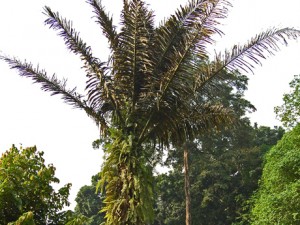
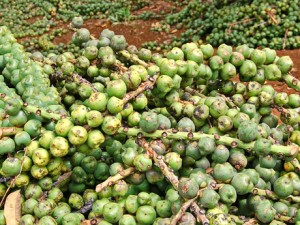
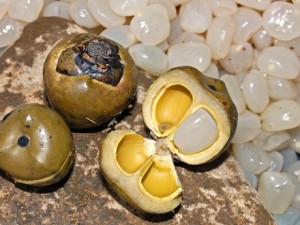
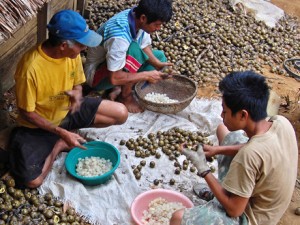
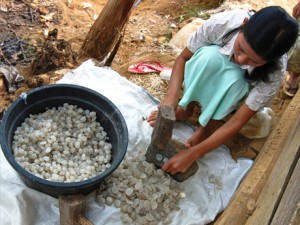
Source plants
- scientific name
- Arecales Arecaceae Arenga Arenga pinnata
Syn.:Arenga saccharifera - general name
- Sugar palm, kolang-kaling
- overview
-
This species, from which kolang-kaling is produced, (hereinafter, sugar palm) grows wild widely from eastern India and Sri Lanka through Bangladesh, Myanmar, Thailand, southern China, Hainan Island, and the Malay Peninsula to New Guinea and Guam. In India, it is cultivated on a mass scale, and in Indonesia, it is partly cultivated and is distributed up to 1,400 m. In the Philippines, it grows mainly in natural forests, and it is estimated that there are 4.67 million trees throughout the country. Data on the resource amounts in other producing countries are not prepared.
Sugar palm is distributed in the life zones from dry to humid forests in subtropical areas and dry to rain forests in tropical areas and grows under a wide range of conditions, with rainfall of 700-4,000 mm, annual average temperature 19-27 degrees C, and soil pH 5.0-8.0. The ideal growth is attained under the following conditions: within elevations of 500-800 m, annual rainfall of 1,200 mm or over, 7-10 humid months, and an annual average temperature of around 25 degrees C. It generally grows in forests, however it is not limited to developed natural forests but it is also possible to grow it on bare gravelly hillsides and barren land. It is commonly distributed in secondary forests around natural forests or woodland near human habitation. It is pointed out that there is the possibility of the tree having been affected by intentional breeding by humans. It shows the maximum growth in fertile, humid soil 0-1,200 m above sea level in humid tropics. It grows at higher elevations than coconut does. It is rarely affected by dryness, typhoons, pests, and fungi. It is strong enough that it does not need special care, and it easily grows in well-drained soil in dark, cold valleys, slopes of mountain streams, fringes of forests, partly cleared hillside and so on. According to reports by the Indochinese-Indonesian Hindustan Diversity Center, sugar palm is disease-resistant, drought-resistant, fungus-resistant, alkali-resistant, and pest-resistant, and can grow in nutrient-poor soil, in the shade, and on slopes. It is said that soil erosion prevention can be expected if it is planted on steep slopes as its root system develops thickly.
As for the growth rate, looking at the example of sugar palm from West Java, Indonesia, 4,500 kolang-kaling are harvested from an infructescence. Meanwhile, in the case of the Philippines for example, an infructescence bears 48 fruits on average, and a tree produces 5,000-7,000 seeds.
Diverse products are made using various parts of sugar palm, such as endosperm, sap, leaves, trunk, fiber, and fruits. Sugar palm is an extremely important and promising plant that provides economic benefits to communities without damaging surrounding forestry ecosystems.
Product characteristics
- use
- Healthy diet food, toppings for confectionery, dry fruits, preservation in syrup, toxicity to fish
- area
- Southeast Asia
- overview
-
Diet food
Kolang-kaling is the endosperm part of sugar palm. It is called kaon in the Philippines. Kolang-kaling has an elliptical shape and translucent white color, and a chewy texture and refreshing taste. A hundred grams of kolang-kaling contains 4 grams of protein, 6 grams of carbohydrates, 16 grams of dietary fiber, 2 grams of fat, 9 grams of calcium, 5 grams of iron, and the calories are as low as about 27 kcal. (http://www.myfitnesspal.com/food/calories/211718948). It is said to be healthy diet food as it supports intestinal movement and contains fiber and is low in calories, and at the same time, strengthens bones and is effective for curing arthritis as it contains a large amount of calcium.Kolang-kaling cooked in sugar syrup or with spices is widely consumed as confectionery. There is also raw and dried kolang-kaling. In case of A. westerhoutii in Thailand, 30-40 kg of endosperm (loog chid) is expected to be obtained from an infructescence, and the labor to extract the endosperms out of four infructescences from one tree and process them is considered to be about two people and two days. Taking harvesting of endosperms (kolang-kaling) in a producing area in North Sumatra, Indonesia for example, infructescences are regarded as the source of sugar, so 1-2 out of 3-12 are used annually for harvesting of kolang-kaling. About 60 kg of kolang-kaling is produced from an infructescence, and a total of 120 kg is produced from a sugar palm. The purchase price from farmers was 2,500 rupiah/kg (about 2.5 USD/kg) as of 2011, and kolang-kaling is sold at markets in the metropolitan area. The harvest period of the fruit is all year around as it blooms in an irregular manner.
Fleshy liquid that covers the outside of the fruit is used as a fish poison as it has strong causticity and it causes pain and inflammation when it attaches to skin.
Export and import trends and demands in Japan
Harvesting endosperms and molasses from a sugar palm and processing them is labor-intensive so that it is becoming less attractive than plants such as oil palm, coffee, and rubber. For this reason, production in Thailand is on a downward trend while import from Laos is increasing. It costs 0.33-0.54 USD/kg and 600 tons of endosperms are imported annually.
In a certain area in Thailand, people annually gain an income of 3,600 USD per family on average by selling loog chid derived from A. westerhoutii without brokers. In another area, 83 families generate an annual income of 42,500-45,000 USD from only this product, which is second in importance to coffee. In Thailand, agreements on harvesting of the fruits are made with land owners, and the land rent is determined depending on the number of palm infructescences. In 2002, it was 12.5 USD per infructescence. A. pinnata is distributed only in some areas in southern Thailand, and almost all are cultivated or semi-cultivated. The plant is mainly used as a source of molasses gathered from stamen infructescences. In Thailand, A. westerhoutii is the most important palm of its kind. Families get 550-3600 USD from harvesting and selling young endosperms while they get 1250-1600 USD from gathering molasses from A. pinnata. In Laos, the endosperms are important non-wood forest products and 1000 tons or more of them are exported to Thailand. Meanwhile, in North Sumatra in Indonesia, the buying price of kolang-kaling derived from A. pinnata from farmers is around 25,000 rupiah (about 2.5 USD)/kg and annual income from kolang-kaling is reported to be 450 USD as molasses is the staple product and endosperms are only by-products.
As seen above, kolang-kaling is an important income source for local residents in major producing countries such as the Philippines, Indonesia, and Laos, and there are no special legal restrictions regarding harvesting of fruits of this species. In Japan, the traded amount is almost zero, but as there are no special regulations regarding processed import products some traders import a small amount of bottled kolang-kaling/kaon.
Market prospects
In Southeast Asian countries, kolang-kaling is widely used in the form of an ingredient of various confectionery and health foods. It has no special odor or taste so it is highly likely that a market on a considerable scale can be formed in Japan if products that suit Japanese people’s palate are developed. In addition, it has an added value as a healthy diet food as it is low in calories and contains dietary fiber and minerals. There is the possibility that a considerable scale market will be formed by developing products such as low-calorie diet confectionery. It is conceivable that material and product supply from producing countries is relatively easy if products that suit the taste of Japanese people are developed as there are companies that sell kolang-kaling in the form of canned and packed products on a large scale in countries such as Indonesia and Thailand.
The issues at the production sites are that it takes a long period of time until kolang-kaling matures, and blooms and bears fruits (it is said to usually take 10-16 years, but there are reports that say it is 5-6 years), and production of kolang-kaling is labor-intensive so it is costly in high wage areas.
- references
-
- Duke J.A. 1989: Arenga pinnata (Wurum) Merr. (Arecaceae) In Handbook of Nuts, pp 30-33, CRC Press LLC
- https://www.giz.de/en/downloads/giz2014-en-survey-natural-resources.pdf
- http://www.pacsoa.org.au/w/index.php?title=Arenga_pinnata
- http://www.worldagroforestry.org/treedb2/speciesprofile.php?Spid=119
- Pongsattayapipat, R. and A.S. Barfod 2009: Economic botany of Sugar palm (Aregna pinnata Merr. and A. weterhoutii Griff., Arecaceae) in Thailand, Thai Journal of Botany, 1(2), 103-117
- Mokoginta, M.M. 2015: Prospective use of palm (Arenga pinnata Merr.) as raw material of sugar palm in the village of Moyag, Bolaang, Mongondow, Indonesia, International J. of Agriculture and Forestry, 5(4), 240-244
- Martini, E. and J.M. Roshetko 2011: Aren (Arenga pinnata (Wurmb)Merr.) traditional management system in Batang Toru, North Sumatra and Tomhon, North Sulawesi, 1st Indonesia, International Conference of Indonesian Forestry Researchers, 552-561, INFOR secretariat.
- Mogea, J., B. Seibert and W. Smits 1991:Multipurpose palms: the sugar palm (Arenga pinnata (Wurmb) Merr.), Agroforestry Systems, 13, 111-129


